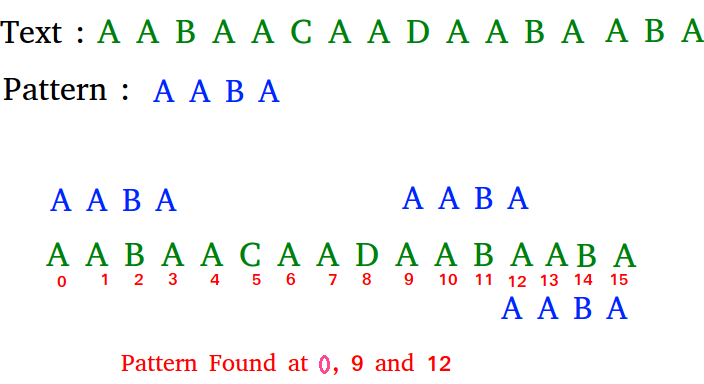What is Pattern Searching ?
Last Updated :
23 Feb, 2024
Pattern searching in Data Structures and Algorithms (DSA) is a fundamental concept that involves searching for a specific pattern or sequence of elements within a given data structure. This technique is commonly used in string matching algorithms to find occurrences of a particular pattern within a text or a larger string. By using various algorithms like the Knuth-Morris-Pratt (KMP) algorithm or the Rabin-Karp algorithm, pattern searching plays a crucial role in tasks such as text processing, data retrieval, and computational biology.

Pattern Searching
We use certain algorithms to do the search process. The complexity of pattern searching varies from algorithm to algorithm. They are very useful when performing a search in a database. The Pattern Searching algorithm is useful for finding patterns in substrings of larger strings.
Below are some of the majorly used pattern searching algorithms:
Naive pattern searching is a simple algorithm used to find all occurrences of a pattern (substring) within a text (string). The algorithm compares the pattern with the text character by character and moves one character at a time if a mismatch occurs.
Time Complexity: O(n*m)
The Rabin-Karp algorithm is a string-searching algorithm that uses hashing to find patterns within a text efficiently. It was developed by Michael O. Rabin and Richard M. Karp. The key idea behind Rabin-Karp is to use a rolling hash function to quickly check for potential matches between the pattern and substrings of the text.
Time Complexity: O(n + m)
The Knuth-Morris-Pratt (KMP) algorithm is a linear time algorithm for string searching. It is more efficient than the naive pattern searching algorithm, especially for large texts, as it avoids unnecessary character comparisons. The key idea behind KMP is to precompute a partial match table (also known as the failure function or lps – longest proper prefix which is also suffix) that helps determine the maximum length of proper suffixes of prefixes, allowing efficient skipping of unnecessary comparisons.
Time Complexity: O(n + m)
Follow the Article to know more about the Pattern Searching Algorithms
The Z algorithm is another linear time string matching algorithm that efficiently finds occurrences of a pattern within a text. It is based on the concept of Z-boxes, which represent the longest substring starting from a given position that is also a prefix of the string. The Z algorithm pre-processes the pattern and text to create a Z-array, which is then used to find the occurrences of the pattern in the text.
Time Complexity: O(n+m)
The Boyer-Moore algorithm is a powerful and efficient string searching algorithm that is widely used in practice. It is known for its ability to skip larger portions of the text when a mismatch occurs, making it particularly efficient for searching in large texts. The algorithm uses two heuristics: the bad character rule and the good suffix rule.
Time Complexity: O(n*m)
Use Cases of Pattern Searching:
Pattern searching algorithms are essential in various applications where finding occurrences of a particular pattern within a larger text or dataset is necessary. Here are some use cases of pattern searching algorithms:
- Text Processing and Editing: Search and replace functionality in text editors or word processors often uses pattern searching algorithms to identify and replace specific patterns or strings.
- Information Retrieval: Search engines use pattern searching algorithms to efficiently find relevant documents or web pages based on user queries.
- Data Mining: Identifying patterns in large datasets, such as finding sequences of events or behaviours, is a common application. Pattern searching helps extract meaningful information from data.
- Bioinformatics: DNA and protein sequence analysis involve searching for specific patterns or motifs. Pattern searching algorithms are crucial in bioinformatics for tasks like gene identification and sequence alignment.
- Image Processing: In image recognition, pattern searching algorithms can be used to identify specific shapes, structures, or textures within an image.
- Network Security: Intrusion detection systems use pattern searching algorithms to identify patterns indicative of malicious activities or security threats in network traffic.
- Database Systems: Database queries often involve searching for specific patterns or values within tables. Indexing and pattern matching algorithms optimize these searches for performance.
- Signal Processing: In signal processing, pattern searching algorithms can be employed to identify specific patterns or trends in signals, aiding in tasks like speech recognition or audio processing.
- Robotics and Computer Vision: Pattern searching is crucial in robotics for object recognition and navigation. Computer vision systems use these algorithms to identify and track objects in a visual field.
Practice Problem on Pattern Searching Algorithm:
Below are some of the Important Pattern Searching Questions:
Share your thoughts in the comments
Please Login to comment...